Yesterday’s liveblog can be found here. For an overview and analysis of this developing story see our latest podcast.
Please help The Interpreter to continue providing this valuable information service by making a donation towards our costs.
View Ukraine: April, 2014 in a larger map
For links to individual updates click on the timestamps.
For the latest summary of evidence surrounding the shooting down of flight MH17 see our separate article: Evidence Review: Who Shot Down MH17?
Below we will be making regular updates so check back often.
Translation: Plane shot down by terrorists yesterday outside Enakievo.
The Ukrainian government has not said why they believe the jet was shot down by a Buk. Perhaps the pilot reported a radar lock, or perhaps he was flying at an altitude that would require a more advanced missile to hit. Regardless, Ukraine’s aircraft continue to struggle against the anti-aircraft threat from the separatists.
The Russian economic outlook is still bleak, but there are signs that its stock markets may have hit bottom and are on its way back up — at least for now. At the close of the day Russia’s MICEX was up 1.24%. Bloomberg reports:
The Micex Index (INDEXCF) rebounded from a three-month low and the ruble gained as Russia said it sought to de-escalate the conflict in Ukraine. OAO Sberbank jumped on bets it won’t be excluded from MSCI Inc.’s local index.
The equity gauge rallied 1.1 percent, the most since July 22, led by a 3.2 percent advance in Sberbank, Russia’s biggest lender, which was affected by European Union sanctions this month. The Micex’s consumer-staple index jumped 3.5 percent on speculation domestic food producers will benefit from an import ban imposed on the U.S. and European Union. The ruble advanced 0.2 percent to 36.2095 per dollar by 8:22 p.m. in Moscow.
Russian assets extended gains, with the ruble erasing losses, after the nation’s Security Council head Nikolai Patrushev said in comments to state news wire RIA Novosti that the country sought to mediate between Ukraine and rebels in the east. The Micex has fallen 2.5 percent this month, pushing valuations to a three-month low.
Ukraine, on the other hand, is facing a very serious series of economic problems:
The Wall Street Journal reports:
Ukraine’s economy shrank 4.7% in the second quarter compared with a year before, the government said last week. The government has announced a “war tax” of 1.5% to fund the military effort, which Ukrainian media have criticized for leaving soldiers woefully underequipped. And Kiev has drafted tens of thousands of Ukrainians to join the fight, making the war hit home in a new way for families across the country.
In Kiev, the capital, where hundreds of thousands of people took to the streets in the winter to protest then-President Viktor Yanukovych’s decision not to bring the country closer to the European Union, many people say they know someone being drafted or otherwise affected by the war.
Russia was facing a series of serious economic challenges before this crisis began, and those problems have only been exacerbated by this crisis. But Ukraine’s economic problems have greatly expanded as this crisis has continued, and the crisis is clearly not yet resolved.
Russia’s
Defense Ministry said on August 8 it has finished military exercises in
southern Russia which the United States has criticized as a
“provocative” step amid the Ukraine crisis.The Defense Ministry
said that aircraft taking part in the exercises have been redeployed
from temporary to their permanent bases, and antiaircraft missile units
were also preparing to leave for their permanent positions.It
said the drills in the southern Astrakhan region 1,000 kilometers from
the border with Ukraine has shown a “high level of cohesiveness” among
troops.
And as RFE/RL points out, Kyiv Post’s Christopher Miller makes an excellent point — does this mean we’re going to witness all those troops withdraw from the border?
In an article for CNN World, Catherine E. Shoiche approached several analysts to try and predict: “What is Putin’s endgame in Ukraine?”
While Russia remains unresponsive to the new economic sanctions and further dug itself in by announcing an import ban on food, CNN discussed five possible motives for Russian meddling in Ukraine:
Is Putin just bolstering support back home? Or is Russia keeping
Ukraine unstable to keep the country from joining the West? Perhaps the
answer lies in the past and Russia is expanding its regional influence
like in Georgia in 2008? Or is Russia merely acting to protect itself,
since fighting is taking place close to Russian territory, as they
themselves seem to believe?
These four scenarios already seem
outdated. Putin’s support is indeed bolstered, but was not dangerously
waning before and, it being a result of unilateral news coverage of the
conflict, could be considered more of an instrument than a goal on its
own.
The idea that studying 2008 Georgia will clarify the
situation in Ukraine is also obsolete. This Five-Day war was fought and
won in lighting speed, permanent destabilization achieved by installing
internationally unrecognized governments. Other than learning that
Russia can and would undertake military action, the Ukrainian military is displaying far fiercer fighting spirit then the Georgians did.
A fifth, most alarming and least rebuttable option was discussed — that Russia is planning to take over territory.
“NATO
warned this week that Russia could use “the pretext of a humanitarian
or peacekeeping mission as an excuse to send troops into eastern
Ukraine.”
As we demonstrated on The Interpreter’s liveblog yesterday,
Russian vehicles marked with ‘Peacekeeping’ insignias are located close
to the Ukrainian border. But even if Russian forces cross into Ukraine,
this does not answer what “Putin’s Endgame” will be.
Paul Gobles’ Windows on Eurasia
column sheds light on a grim premonition of the Russian historian Yuri
Feltshtinsky, who concludes “Vladimir Putin has set the world’s clock
back to July 1938.” According to Felshtinsky, the world is reacting to Putin in the same way it did to Germany when Hitler annexed Sudetenland:
“After
the occupation of Crimea the world has sent Putin the following signal:
‘Tell us that the foreign policy expansion of Russia will end with the
occupation of Crimea and we will forgive everything and happily and
peacefully begin to live again in the old way.But in response,
Putin declared that “Russia is beginning (only beginning) to correct the
great historical injustice of 1991 when the Soviet Union fell apart and
territories were lost by Russia,” he continues.”
The International Business Times reports that Sergei Zakharov, an artist who has produced anti-separatist works around the city of Donetsk, has been abducted by separatist militants according to local reports.
Zakharov’s most recent, and widely distributed work was an image of the separatist military leader Igor Girkin holding a gun to his own head with the text “just do it” beneath:
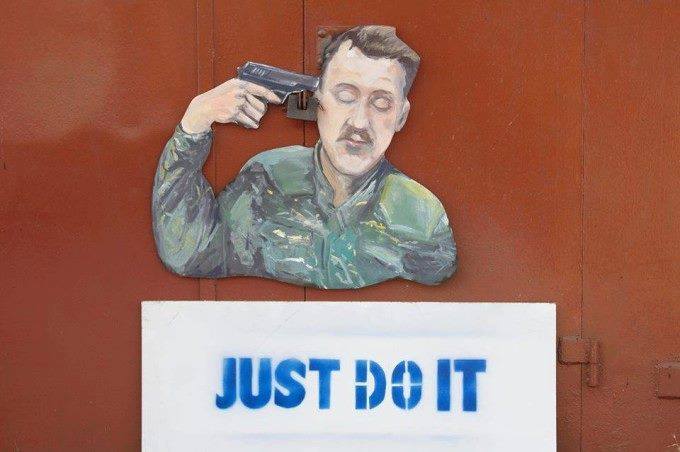
The report says:
The brother of the artist Andrei Zakharov said the kidnapping took place overnight. According to a neighbour’s account:
“Four armed men with the DNR identification marks were taking Sergei out of the house. They were also carrying his laptop and a box – most likely it was a box with flyers for future actions. The neighbour asked them why are taking him and to where, but the terrorists claimed they were a rapid response team, and didn’t know the details. They were told to get him – and that’s what they’re doing.”
Sergei Mzurkiewicz, a spokesman for Zakharov’s Murzilki art group, wrote on his Facebook page:
“He was taken to an unknown destination. We haven’t been able to contact him. If anyone has any ideas about a possible release, please write to me in private.”
We opened today’s liveblog with a report that separatists had made gains near Dolzhansky, Dyakovo and Krasnopartizansk. That area is crucial as we’ll explain.
The National Security and Defense Council of Ukraine regularly releases maps of the current military situation in Ukraine. While the SNBO maps have been widely criticized as being too optimistic for the Ukrainian government they also none-the-less show the focus of the Ukrainian military. This is a map released on July 11th (about a week before MH17 was shot down). Note the circled area.
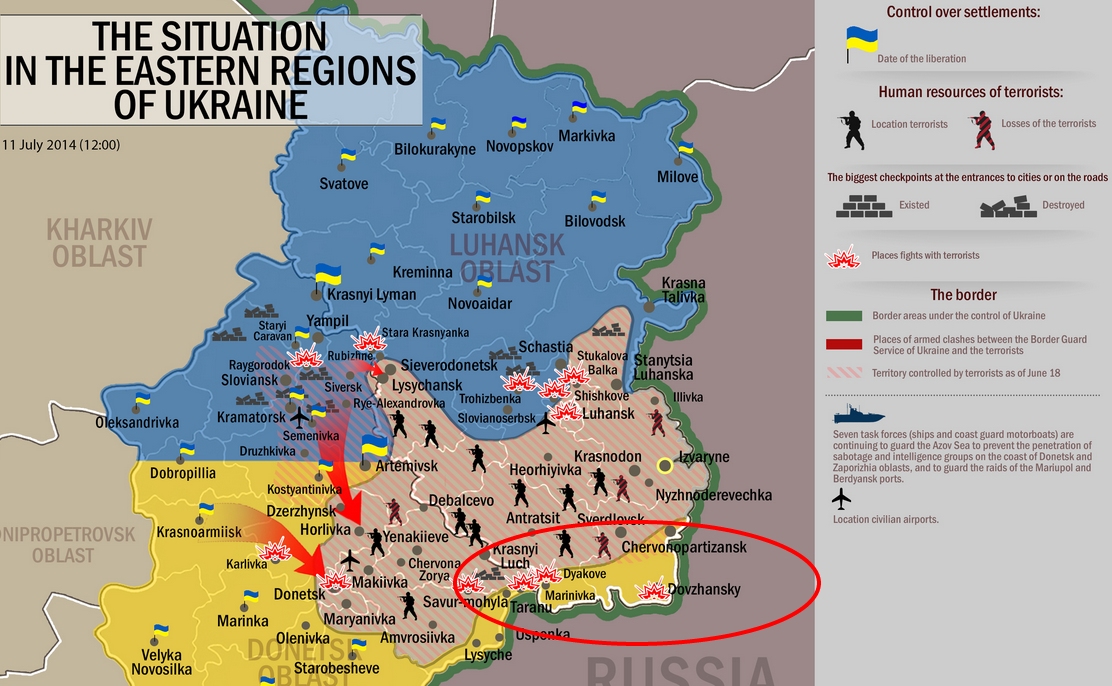
Now note this map from July 21st. The separatist control of the area south of Savor-Mohyla (Saur-Mogila) has shrank, as has some of the area near Dyakovo.
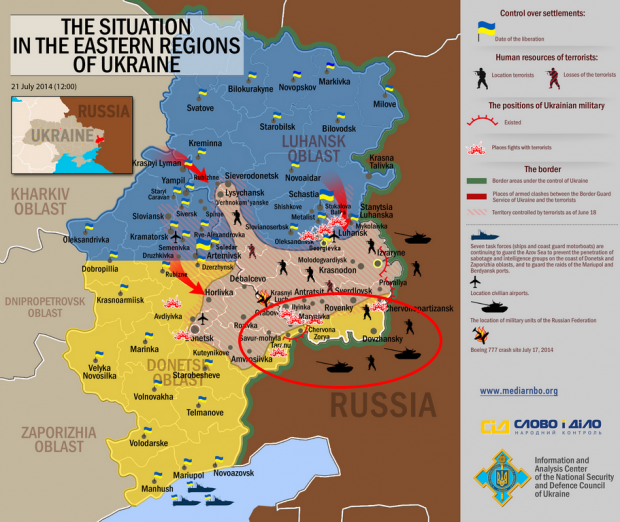
Now look at what happens by July 30:
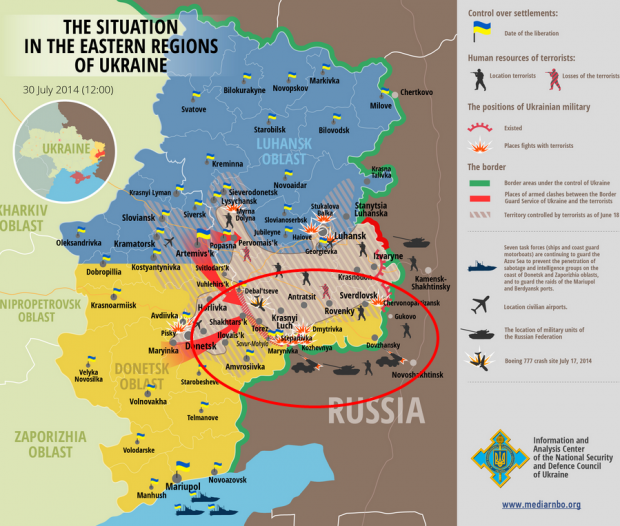
This area has been under heavy Grad rocket attack from Russia, however, and large amounts of troops, armor, and tanks have entered this area from Russia in the last two weeks. On the eastern border, more than 400 Ukrainian soldiers near the Gukovo crossing were forced to flee across the border into Russia. As a result, by August 5th there is almost no change here.
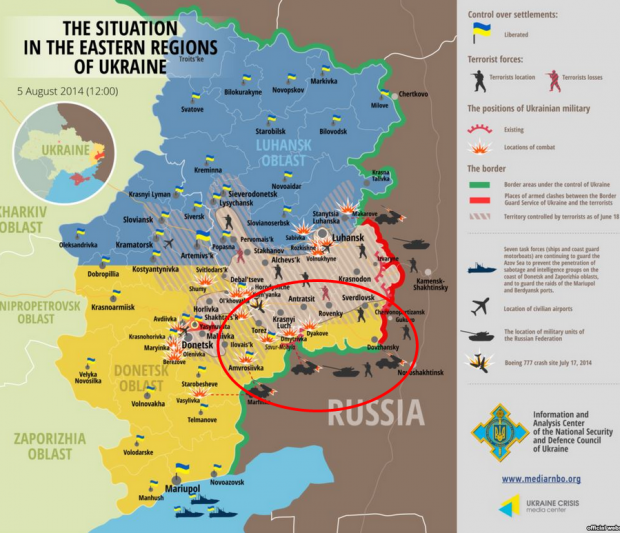
Today The Interpreter has edited the August 5th map to the situation after Ukrainian forces, trapped in the pocket highlighted above, successfully broke out to the west near Saur-Mogila and withdrew from the area.
While the withdrawal of the Ukrainian troops and border guards, who have been attacked from both the separatists to their west and north, and Russian artillery and rockets from across the border to their east and south, has relieved over a thousand troops from a prolonged and horrible situation, it leaves a large area of the border undefended.
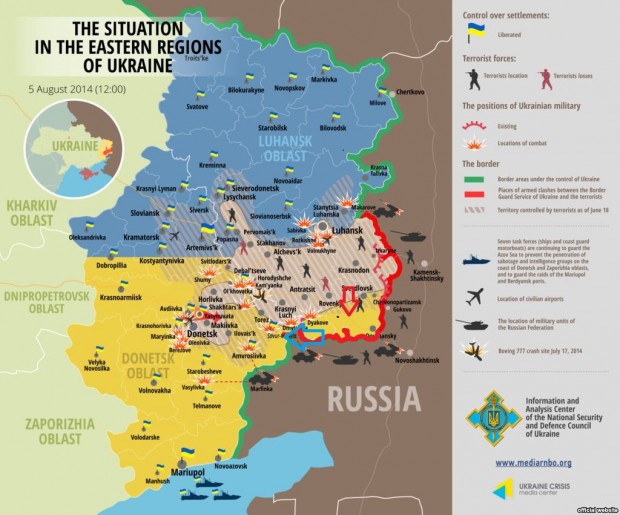
In our latest podcast we discuss whether Russia will outright invade Ukraine, and while there is a frighteningly-high chance that it could happen as early as tonight, chances are that an outright invasion may still be avoided. The Interpreter’s editor-in-chief Michael Weiss writes in Foreign Policy that Putin’s actions near Ukraine don’t look like simple scare tactics:
If Putin only wanted to scare Ukraine, or to exercise a little hard-power leverage with the West, he wouldn’t hide his toys from U.S. satellites flying overhead. He’d signpost them.
But Weiss also points out that there “Russia’s invasion of eastern Ukraine won’t be an armored blitzkrieg. It’s a slow, seditious drip — and it’s already underway.”
A full-scale invasion and occupation may be disastrous, as Russian military analyst Alexander Golts and U.S. Naval War College professor John Schindler have argued. But Moscow may only be looking to establish supply “corridors” inside Ukraine, under the guise of a humanitarian intervention, to ensure the continued flow of weapons to its proxies. In this respect, Russia’s role in eastern Ukraine could resemble Hezbollah’s in the Qalamoun region of Syria, where the Party of God has, with mixed results, spent months trying to keep a direct line of martial aid flowing from Damascus, thereby keeping the anti-Assad rebellion well away from another volatile and fast-eroding border — the one between Syria and Lebanon.
There are hard interests for Moscow at stake here, even if they come in the guise of softer humanitarian concern. Propaganda usually precedes aggression, and the Kremlin’s messaging in the last few days points to “peacekeeping” as the newest banner of maskirovka.
That “seditious drip” has already given the separatists enough firepower to regain some territory today — border territory which will help Russia expand it’s “corridors” into eastern Ukraine. Now it remains to be seen how far the separatists will advance, and how much more Russian military firepower they’ll have at their backs as they try.
Ivan Voytenko, commander of the 72nd mechanised brigadeVitaliy Dubinyak, deputy commander of the brigadeAleksandr Polyakov, commander of the tank battalionOleksandr Okhrymenko, staff officerDmitriy Ustilko, company commander
“In their testimonies, the detainees acknowledge that the fact of their participation in military combat and the use of various types of weapons. However they deny that they used these weapons against civilians.”
However, the representative of the SKR said that the investigation has evidence that in fact, the 72nd brigade, on the orders of commander Voytenko, from July 19 to August 3, during the shelling of the towns of Krasnopartizansk and Krasnodon in the Lugansk region, used heavy weapons indiscriminately, as a result of which no fewer than 10 civilians were killed or wounded and no fewer than 20 residential buildings and sites of infrastructure were destroyed. According to the SKR representative, this information was confirmed by the testimonies of other Ukrainian soldiers who had served in this brigade and crossed over into Russian territory.Markin elaborated that investigators are looking into the involvement of the detainees in the use of munitions, loaded with the incendiary compound N-17 (so called phosphorous shells, banned by international conventions). In addition, they are looking into their involvment in the shelling of Russian territory.“Now instead of triumphal marches in their honor on the Maidan, which they likely imagined instead of the promised rewards, they are awaited by a banal trial, there is a sentence, and in the end, a just punishment,” said Markin.
1. Cruel treatment of prisoners of war or civilians, deportation of civilian populations, plunder of national property in occupied territories, and use in a military conflict of means and methods of warfare, banned by an international treaty of the Russian Federation,shall be punishable by deprivation of liberty for a term of up to 20 years.
Markin also claimed that more than 400 of the Ukrainian soldiers and border guards who crossed, having run out of ammunition while under attack, into Russian territory on August 4, had been questioned as witnesses.
All translations by The Interpreter.
UNIAN reports that 32 tonnes of non-lethal military equipment, supplied from Canada to Ukraine, is due to arrive on a Royal Canadian Air Force aircraft at Borispol airport today.
The equipment is bound for Ukrainian border guards operating in the conflict zone in the east of the Donetsk and Lugansk regions.
The official ceremony for the handover of the equipment will be attended by the parliamentary secretary to the Canadian minister of national defence, James Bezan, the acting Canadian ambassador, Anne Mattson-Gauss, and the director of the international law department of the State Border Guard Service of Ukraine, Oleksandr Melnykov.
Yesterday, Reuters reported that Canada had announced that it was to send a wide range of non-lethal military supplies to Ukraine.
The Canadian prime minister, Stephen Harper, said that:
“This equipment, which includes helmets, ballistic eyewear, protective vests, first aid kits, tents and sleeping bags, will provide physical and medical protection to those on the front lines against the insurgency.”
There has been a small explosion in Kiev outside the Ukrainian House convention and exhibition centre.
UNN reports that, according to paramedics at the scene, at last two people have been injured by the blast.
They have photos of the aftermath here:



UNIAN reports that 5 Ukrainian officers are to be tried in Russia on charges of shelling Russian territory. The officers are the last 5 remaining Ukrainian servicemen still in Russia from the group of Ukrainian servicemen who were forced to seek refuge from separatist attack in Russian territory on August 4. The last group of 48 servicemen left yesterday.
UNIAN reports from the Ukrainian consulate in Rostov-on-Don (translated by The Interpreter):
According to the agency’s source, the Russian side is holding a trial at a secret time and location, but it is believed that it will take place tonight in either Donetsk or Gukovo (both in the Rostov region).
The consul said that the Ukrainian soldiers would most likely be detained for 2 months. They are charged with utilising forbidden methods of warfare.
The consul described the proceedings as a “provocation,” comparing them with the trial in Voronezh of Nadezhda Savchenko, a Ukrainian pilot who was illegally rendered from separatist detention across the border into Russia and put on trial for the murder of 2 Russian journalists.
According to the consul, the Ukrainian officers are currently in investigative pre-trial detention in Donetsk in the Rostov region. They are accused of shelling Russian territory.
There are reports that more than 1,000 Ukrainian troops and border guards have broken out of an area along the border in which they have been trapped by separatist forces for several weeks. The successful withdrawal does, however, leave a large section of the border with Russia unsecured. This gap is likely to be useful for the infiltration of Russian weapons and separatist fighters, and may even be of strategic importance in the event of a Russian invasion.
LIGA Novosti reports that a source in the ATO headquarters has given them details on the evacuation. According to the source, the operation was conducted from two sides, with Ukrainian forces advancing from their current positions near Saur-Mogila to open a corridor, as the besieged units moved away from the border towards them. The operation was a success and the groups were able to connect and the encircled forces able to withdraw westwards.
The servicemen who were evacuated had been encircled in the area around Dolzhansky, Dyakovo and Krasnopartizansk, known as Sector D. These areas have been under heavy, regular attacks from both separatist fighters and Russian artillery and Grad rockets, fired from across the border.
Amongst those who were withdrawn were members of the 72nd, 24th and 51st mechanised brigades, the 79th airborne brigade, the 3rd special forces regiment and border guards.
The troops left the area in their own vehicles but destroyed all the equipment that they were unable to take with them.
According to Yuri Butusov the editor-in-chief of Censor.NET, six border guards and three soldiers were killed during the breakout. Details on wounded are still emerging.